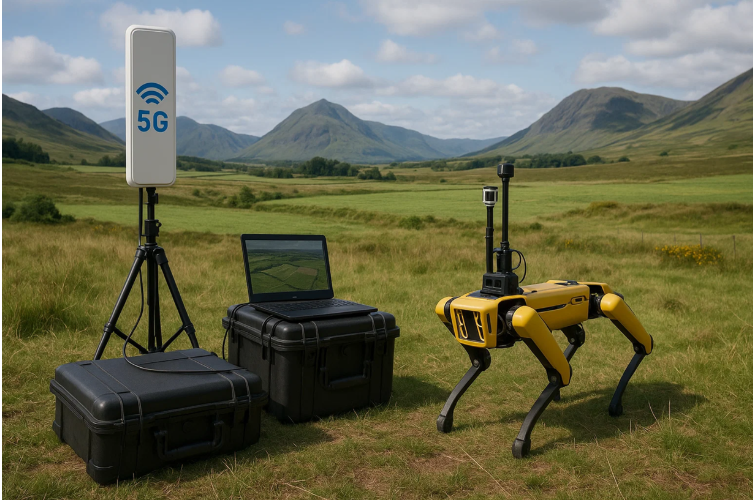China’s 5G Vehicles with Uppåtgående RF Drive Test Tools & Wireless Survey Software
As of 2025, China is at the forefront of integrating 5G connectivity into the automotive sector. According to recent projections, about 30% of all new cars sold in China this year will come equipped with 5G communication modules. This adoption rate is expected to grow to 95% by 2030, positioning the country to lead in connected and automated vehicle technologies.
This shift is not limited to consumer demand—it reflects national policy, coordinated standardization efforts, and a maturing 5G network infrastructure. The goal is not just to offer fast mobile connectivity within vehicles, but to create a coordinated system where vehicles, roads, and cloud infrastructure interact in real time. So, now let us look into 5G-Connected Vehicles in China along with RantCell’s LTE RF drive test tools in telecom & Cellular RF drive test equipment and RantCell’s Wireless Survey Software Tools & Wifi site survey software tools in detail.
Infrastructure Foundation: 5G Network Expansion
These base stations are key for enabling ultra-reliable low-latency communication (URLLC), which is critical for automotive applications that depend on real-time decision-making.
Unlike 4G, which focused on consumer broadband, 5G is engineered for broader applications, including automotive systems. Features such as network slicing allow carriers to isolate traffic for specific functions—such as infotainment vs. vehicle control—ensuring performance requirements are met consistently.
Vehicle Architecture: Integrating 5G into the Stack
Most modern vehicles rely on an internal network of Electronic Control Units (ECUs), which manage everything from braking to navigation. The addition of 5G modules connects these systems to external data sources in real time. This enables functions such as:
- Real-time HD map updates
- Over-the-air firmware upgrades
- Telematics and diagnostics monitoring
- Remote control and assistance
- Sensor data sharing for coordinated driving
The integration typically involves a Telematics Control Unit (TCU) with a 5G modem and SIM capability, which is connected to the vehicle’s CAN bus or Ethernet backbone. The TCU acts as the bridge between the vehicle and the cellular network, sometimes supported by edge computing for preprocessing sensor data.
V2X: Beyond Internet in the Car
This includes:
- V2I (vehicle-to-infrastructure): Communicates with traffic lights, road signs, and toll systems
- V2N (vehicle-to-network): Connects with centralized cloud systems for traffic management or fleet monitoring
- V2P (vehicle-to-pedestrian): Alerts nearby mobile users of vehicle presence in certain zones
These capabilities are critical for the development of Level 3 and above autonomous driving, where vehicles must respond not only to onboard sensors but also external data about changing road conditions, nearby vehicles, or pedestrian movement.
National Push: Vehicle-Road-Cloud Pilot Zones
To accelerate deployment, China’s Ministry of Industry and Information Technology (MIIT) announced in July 2025 that 20 cities and regions have been designated as official pilot areas for “Vehicle-Road-Cloud Integration.”
These zones are being equipped with smart traffic signals, roadside sensors, and edge computing infrastructure. Vehicles operating in these zones will be able to receive and transmit data about road conditions, construction zones, and real-time traffic rules. Some pilot projects are already demonstrating automated lane merging, adaptive traffic signal control, and remote emergency assistance.
This project ties into the broader national “Intelligent Connected Vehicle” (ICV) framework, which sets out the technical and regulatory foundation for future mass-market deployment of autonomous and semi-autonomous vehicles.
Hardware Trends: Module Penetration and Cost Decline
The majority of connected vehicle platforms are now shipped with integrated NAD (Network Access Device) modules that support 5G. Now, the shift to 5G is accelerating, especially for passenger vehicles equipped with advanced driver-assistance systems (ADAS).
In 2024, around 20% of vehicles in China had 5G modules. That number is expected to reach 50% by 2027, driven by both regulatory push and falling module costs. The cost of 5G NADs has dropped by over 40% since 2021 due to scale and chipset maturity.
While early systems required custom boards and multiple antennas, modern vehicle designs are embedding 5G modems directly into TCUs with multi-band support for NR (New Radio), LTE fallback, and GNSS (Global Navigation Satellite System) integration.
Software Ecosystem: Evolving Standards and Compatibility
As 5G-connected vehicles become more common, software frameworks are adapting to new requirements. Operating systems used in automotive ECUs now support modular 5G communication stacks, secure over-the-air update mechanisms, and dynamic policy-based data routing.
China’s automotive industry is also aligning around open protocol stacks for V2X communication, such as C-V2X (Cellular-V2X), based on 3GPP Release 14 and above. These standards ensure compatibility between different brands of vehicles and infrastructure hardware. The 3GPP Release 17 and upcoming Release 18 further improve sidelink communications and range for vehicular applications.
Security and Compliance: Challenges on the Road Ahead
The large amount of data transmitted between vehicles and networks raises concerns about cybersecurity. Vehicle manufacturers and telecommunication authorities are working together to implement secure communication protocols, including:
- End-to-end encryption between TCUs and cloud services
- Secure firmware updates using signed packages
- Authentication frameworks for V2X endpoints
- Intrusion detection systems for in-vehicle networks
China’s “Cybersecurity Law” and “Data Security Law” are also impacting the design of connected vehicles by imposing rules on cross-border data transfer and user privacy. Vehicle OEMs must now ensure that cloud storage and processing for Chinese vehicles remains within national borders unless otherwise approved.
Outlook: 2025–2030 Milestones
By 2025:
- ~30% of new vehicles sold in China will include 5G connectivity
- All major vehicle OEMs will support NAD-based designs
- Pilot zones for vehicle-road-cloud integration will be operational in at least 20 provinces
By 2027:
- Over 50% of new passenger cars will include V2X-capable modules
- Real-time traffic optimization using connected vehicle data will be deployed in major urban areas
By 2030:
- Up to 95% of vehicles will include 5G support by default
- Cross-brand compatibility for V2X will be standard
- China aims to lead globally in connected autonomous vehicle deployment
Conclusion
China’s automotive and telecommunications sectors are aligning to deliver a robust 5G-connected vehicle ecosystem. The current focus is on deploying infrastructure, refining V2X protocols, and integrating secure, high-performance hardware into vehicles. As technical standards mature and module costs continue to decline, adoption is expected to accelerate steadily through the end of the decade.
By combining high-speed mobile communication with intelligent systems and cloud platforms, China is creating the foundation for advanced mobility solutions that are safer, smarter, and more efficient.
About RantCell
RantCell is a mobile network testing solution designed for operators, consultants, and enterprises to measure and monitor 2G, 3G, 4G, and 5G network performance using smartphones. Without the need for expensive hardware or traditional drive test kits, RantCell enables remote and automated testing, saving time and cost. With support for active testing, crowdsourcing, and Layer 3 measurements, RantCell helps identify coverage gaps, quality issues, and performance bottlenecks in real time. Also read similar articles from here.





